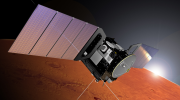This sent in from Andy Johnstone at ESOC, ESA’s Space Operations Centre in Darmstadt, just a few minutes ago.
Everything is running smoothly at the moment! James Godfrey and I have been at ESOC since about 17:00GMT (18:00 local); I will stay on through the night and he will come back in with Erhard Rabenau at around 06:00GMT (07:00CET) on Sunday morning.
Acquisition of signal by ESA’s New Norcia ground tracking station was on time today at 18:19GMT (19:19 CET) via both X- and S-Band frequencies.
This animation shows the flyby on 29 Dec 2013 (speeded up) as if you were standing on Phobos, with Mars in the background and Mars Express sweeping out an arc above. Toward the end of the sequence, Mars Express disappears behind Mars and out of sight of Phobos. Thanks to the MEX team and Simon Wood at ESOC for generating this!
We have had our first period where we switch off the telemetry modulation [that is, downloading information from MEX] and only receive a carrier signal [just a raw radio signal] from the spacecraft.
Setting Mars Express to transmit carrier only increases the strength and quality of the signal, which therefore gives us better radio science, But this is always a worrying period for the Flight Control Team as we cannot tell what is happening on board the spacecraft. All we have to go on during these periods is a spectrum analyser and a display from the ground station saying that a signal is still being detected.
The next scheduled event will be loss of signal at 00:25GMT (01:25CET) when Mars Express passes behind Mars; it will reappear at the end of this occultation at 00:53GMT (01:53CET). This in itself is a good opportunity for radio science as our scientists can obtain information on Mars’ atmosphere by the way the radio signal is affected as it briefly passes through en route to Earth.
We are looking forward to a quiet night with everything running as planned!
Best regards
— Andy Johnstone
Spacecraft Operations Engineer, TT&C, Mars Express




Discussion: no comments